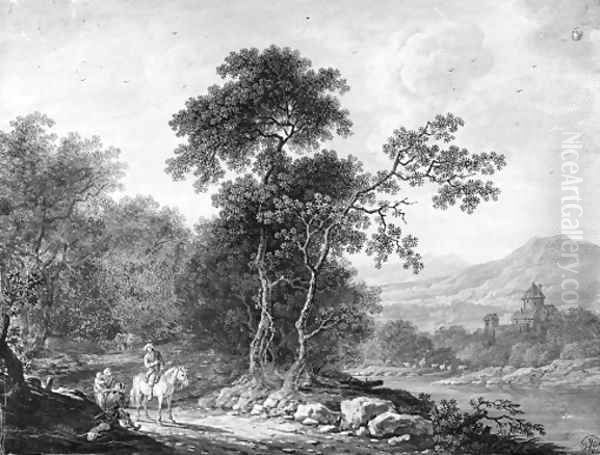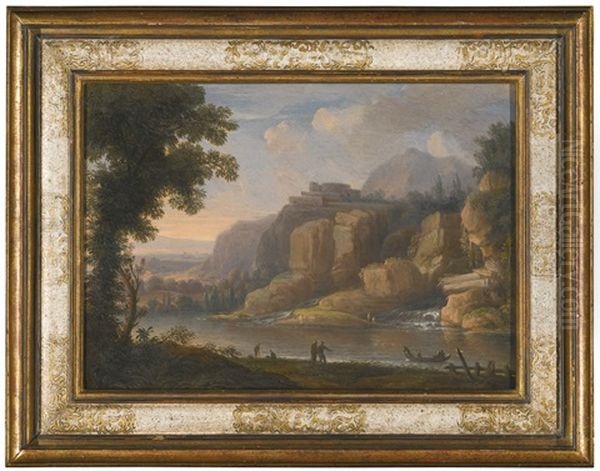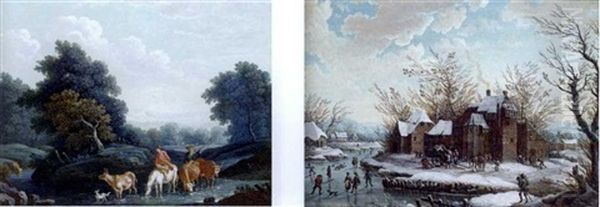Christoph Ludwig Agricola stands as a notable, if sometimes overlooked, figure in the landscape of late 17th and early 18th-century German art. A painter and etcher, he carved a niche for himself with his evocative, atmospheric landscapes that captured the nuances of light and weather, heralding an early form of Romantic sensibility within the established Baroque tradition. His life, marked by extensive travels and a largely self-directed artistic education, resulted in a body of work that, while influenced by continental masters, possessed a distinct character appreciated in various European centers.
Early Life and Formative Years in Regensburg
Christoph Ludwig Agricola was born in Regensburg, a historic city in Bavaria, Germany, on November 5, 1667. He also passed away in his birth city on August 8, 1719. While some older sources occasionally cite slightly different dates (such as a birth year of 1665 and death in 1724), the consensus among modern art historical scholarship firmly supports the 1667-1719 timeline. Regensburg, with its rich medieval and then-contemporary cultural environment, would have provided the initial backdrop for his burgeoning artistic inclinations.
A particularly intriguing aspect of Agricola's early development is that he is widely considered to have been largely self-taught. In an era where apprenticeship under an established master was the conventional path to an artistic career, Agricola’s independent study marks him as an individual of considerable determination and innate talent. He likely honed his skills by meticulously studying and copying the works of other artists available to him, a common practice for aspiring painters, but one he seems to have pursued with exceptional focus in the absence of formal, continuous tutelage. This self-reliance may have also contributed to the unique blend of influences and personal vision evident in his later work.
The Grand Tour of Influences: Poussin, Lorrain, and Dughet
The art of Christoph Ludwig Agricola is deeply indebted to the towering figures of 17th-century French classicism and Italianate landscape painting, particularly Nicolas Poussin, Claude Lorrain, and Gaspard Dughet (also known as Gaspard Poussin, as he was Nicolas Poussin's brother-in-law and pupil). These artists, though French by birth or primary association, spent significant portions of their careers in Italy, and their work became a touchstone for landscape painters across Europe.

Claude Lorrain, renowned for his idealized landscapes bathed in a soft, golden light, often depicting biblical or mythological scenes within expansive, harmonious natural settings, clearly left an imprint on Agricola. The German painter’s attention to atmospheric effects, the subtle gradations of light at dawn or dusk, and the creation of depth through aerial perspective echo Lorrain's mastery. Agricola, like Lorrain, often sought to capture not just the topography of a scene, but its mood and the ephemeral qualities of its illumination.
Nicolas Poussin’s influence can be seen in the structural integrity and often classical or pastoral themes that sometimes appear in Agricola’s compositions. Poussin was a master of ordered, intellectually conceived landscapes where nature, though majestic, was often arranged to serve a narrative or philosophical purpose. While Agricola’s work tends towards a more direct engagement with the sensory experience of nature, the underlying principles of balanced composition found in Poussin’s oeuvre would have been part of the artistic language he absorbed.
Gaspard Dughet, who specialized more exclusively in landscapes than his brother-in-law, offered a vision of nature that was often wilder and more untamed than Lorrain's, yet still imbued with a classical sensibility. Dughet's depictions of the Roman Campagna, with its rugged terrain, dramatic skies, and ancient ruins, provided a model for capturing the sublime aspects of the natural world. Agricola’s own interest in portraying stormy skies or the dramatic play of light and shadow across varied terrains aligns with Dughet’s approach. The influence of these three masters provided Agricola with a rich visual vocabulary to interpret and represent the natural world.
Extensive Travels: A Pan-European Artistic Journey
Agricola's artistic development was significantly shaped by his extensive travels throughout Europe. He did not remain confined to Germany but embarked on journeys that took him to England, the Netherlands, France, and, crucially, Italy. These travels were not mere sightseeing expeditions; they were opportunities for artistic immersion, allowing him to study firsthand the works of diverse masters, observe different landscapes, and absorb various cultural influences.

His time in the Netherlands would have exposed him to the rich tradition of Dutch Golden Age landscape painting. Artists like Jacob van Ruisdael, with his dramatic and emotionally charged depictions of forests, waterfalls, and seascapes, or Aelbert Cuyp, celebrated for his tranquil scenes bathed in a warm, hazy light, offered different but equally compelling approaches to landscape. The Dutch emphasis on realism and the careful observation of local scenery, even when idealized, would have provided a counterpoint or complement to the Italianate classicism he admired. Furthermore, the works of Dutch Italianate painters such as Jan Both and Nicolaes Berchem, who combined Dutch observational skills with Italian light and scenery, would have been particularly relevant to his interests.
In France, he would have had further opportunities to engage with the legacy of Poussin, Lorrain, and Dughet, perhaps seeing their works in prominent collections or encountering contemporary artists working in their tradition. His visit to England is less documented in terms of specific artistic impact, but it added another layer to his cosmopolitan experience.
The Italian Sojourn: Rome, Naples, and Venice
Italy, the mecca for artists of the period, held a special significance for Agricola. He spent considerable time in Naples and Rome, cities that were vibrant artistic centers. In Rome, he would have walked the same ground as his French heroes, studying the classical ruins and the distinctive light of the Roman Campagna that had inspired them. The city was a living museum, offering unparalleled access to masterpieces of antiquity and the Renaissance, as well as the works of contemporary Italian artists. He may have encountered the dramatic, often turbulent landscapes of Salvator Rosa, an influential Neapolitan painter whose work prefigured Romanticism and offered a stark contrast to the serenity of Claude Lorrain.
His stay in Naples, a bustling port city with a dramatic natural setting dominated by Mount Vesuvius, also provided rich subject matter. The southern Italian light and landscape offered different qualities from those of central Italy or northern Europe. It was during his Italian period that Agricola's style likely crystallized, as he synthesized the influences he had absorbed with his own observations and artistic temperament.
Evidence also suggests Agricola worked in Venice, a city with its own unique artistic traditions and luminous atmosphere. Records indicate he produced several works for the prominent Venetian collector Zaccaria Sagredo. This connection underscores his growing reputation and ability to secure patronage in competitive artistic environments. The Venetian school, with masters like Titian and Tintoretto (from an earlier era but whose influence persisted), was renowned for its emphasis on color and light, which may have further refined Agricola's handling of atmospheric effects.
Artistic Style: Atmospheric Realism and Early Romantic Sensibilities

Christoph Ludwig Agricola is best characterized as a painter of atmospheric landscapes. His primary artistic concern was the faithful yet evocative depiction of nature, with a particular emphasis on capturing specific times of day and weather conditions. He excelled in rendering the subtle play of light and shadow, the humid haze of a summer evening, the dramatic darkness preceding a storm, or the tranquil glow of twilight. This focus on transient atmospheric effects is what leads many art historians to describe his style as an "early manifestation of Baroque Romanticism in German painting."
While operating within a broadly Baroque framework, which often favored grandeur and dynamic compositions, Agricola’s work frequently exhibits a more intimate and observational quality. His landscapes are not always populated with mythological or biblical figures in the manner of Claude Lorrain or Nicolas Poussin. Instead, the landscape itself, and the atmosphere it conveys, often becomes the primary subject. He was adept at creating a sense of depth and space through careful gradations of color and tone, drawing the viewer into his scenes.
His palette was typically rich and nuanced, capable of conveying both the warmth of sunlit vistas and the cool, somber tones of approaching night or inclement weather. His brushwork, while precise enough to render details, often had a softness that contributed to the overall atmospheric quality of his paintings. He sought a verisimilitude that was not merely photographic but aimed to capture the feeling of a place and moment.
Diverse Themes and Subjects
Beyond his signature atmospheric landscapes, Agricola’s oeuvre included a variety of subjects, showcasing his versatility. He was a skilled painter of small-scale cabinet pictures, which were highly prized by collectors for private contemplation. These often featured meticulous depictions of nature, demonstrating his keen observational skills.
A notable and distinct part of his output consists of natural history subjects, particularly detailed watercolor studies of birds, often executed on vellum or parchment. These works reveal a scientific curiosity alongside artistic skill, placing him in a tradition of artist-naturalists. The precision and delicacy of these bird studies highlight his mastery of the watercolor medium and his patient attention to the intricacies of the natural world. Such works were popular among learned collectors who appreciated both their aesthetic appeal and their informational content.
Agricola also explored Orientalist themes, depicting scenes such as "A Landscape with Orientals Resting" or Turkish funerals and weddings. This interest in exotic, faraway lands was part of a broader cultural trend in Europe during the 17th and 18th centuries, often referred to as "Turquerie." These paintings allowed for imaginative compositions and the depiction of colorful costumes and unfamiliar customs, appealing to a taste for the novel and the picturesque.
Furthermore, as an etcher, Agricola translated his landscape visions into the print medium. His etchings, though perhaps less numerous than his paintings, would have allowed for wider dissemination of his imagery and demonstrated his proficiency in another artistic technique.
Representative Works and Their Characteristics
While a comprehensive catalogue raisonné might be elusive for an artist like Agricola, several works and types of works are representative of his style and concerns.
"A Landscape with Orientals Resting," now housed in the San Francisco Museum of Modern Art, is a fine example of his engagement with Orientalist themes integrated into a landscape setting. Such a work would combine his skill in landscape depiction with figure painting and an imaginative rendering of an exotic scene, likely appealing to the contemporary taste for the picturesque and the foreign.
His numerous atmospheric landscapes, often untitled or generically titled (e.g., "Italianate Landscape," "River Landscape with Figures"), form the core of his reputation. These pieces would typically feature rolling hills, clusters of trees, perhaps a distant body of water or mountains, all unified by a carefully observed and rendered light. Figures, when present, are often small, serving to animate the scene or provide a sense of scale rather than being the primary focus. The mood might range from serene and pastoral to subtly melancholic or dramatic, depending on the time of day and weather depicted.
The bird studies on vellum are another key category. These would be characterized by their delicate execution, accurate depiction of plumage and form, and often a simple, uncluttered background that focuses attention on the subject. Each feather, the glint in an eye, or the subtle coloration of a beak would be rendered with precision.
His etchings would likely echo the themes of his paintings, translating his atmospheric landscapes into the linear medium of print. These would showcase his ability to create effects of light and shadow through varying densities of line and cross-hatching.
Contemporaries and Artistic Milieu
Agricola operated within a vibrant European art world. Besides his key French influences (Poussin, Lorrain, Dughet), he would have been aware of, and potentially interacted with, a range of other artists. In Italy, beyond Salvator Rosa, figures like Giovanni Paolo Panini were gaining fame for their vedute (view paintings) of Rome, capturing its ancient monuments and contemporary life.
In Germany, contemporary landscape painters included figures like Johann Franz Ermels, who also specialized in idealized landscapes, and later, Johann Georg von Hamilton, known for his animal paintings often set in landscapes. While Agricola was somewhat unique in his specific blend of influences and focus on atmospheric effects, he was part of a broader Northern European tradition that was increasingly engaging with Italianate models. The earlier German artist Adam Elsheimer, though from a preceding generation, had been a pioneer in small-scale cabinet paintings with innovative light effects and atmospheric depth, and his legacy might have indirectly influenced the artistic environment Agricola emerged from.
The Dutch artists mentioned earlier—Jacob van Ruisdael, Aelbert Cuyp, Jan Both, Nicolaes Berchem, and even Philips Wouwerman, known for his lively landscapes with horses and figures—were immensely popular and their works widely collected, meaning Agricola would have undoubtedly encountered their paintings or prints during his travels, particularly in the Netherlands and Germany.
Teaching, Influence, and Legacy
Christoph Ludwig Agricola’s impact extended through his own works and through the artists he influenced. He is known to have had pupils, ensuring the transmission of his artistic approach. One of his most notable students was Johann Alexander Thiele. Thiele went on to become a significant landscape painter in his own right, particularly active in Saxony, where he served as a court painter. He absorbed Agricola's interest in depicting specific German landscapes, often with a similar attention to atmospheric detail, though his style evolved with its own characteristics.
Another artist who came under Agricola's influence was Christian Hilfgott Brand. Brand, who later settled in Vienna and became a respected landscape painter, reportedly met Agricola in Regensburg during his youth. This encounter is said to have sparked Brand's interest in painting and set him on his artistic path. Brand’s subsequent development of his own landscape style, which also emphasized atmospheric conditions and naturalistic detail, shows a lineage traceable, at least in part, to Agricola's example.
Agricola's broader legacy lies in his contribution to the development of landscape painting in Germany. By synthesizing Italianate and French classical influences with a personal sensitivity to light and atmosphere, he helped pave the way for later generations of German landscape artists who would further explore the expressive potential of nature. His work can be seen as a bridge between the more formal compositions of the High Baroque and the burgeoning Romantic sensibility that would come to full flower in the later 18th and 19th centuries.
Later Recognition and Collections
While Christoph Ludwig Agricola may not have achieved the superstar status of some of his Italian or French contemporaries during his lifetime, his work was appreciated and collected. His paintings found their way into notable collections across Europe. Today, his works are held in various prestigious museums, a testament to their enduring quality and art historical significance.
Museums in Germany, such as those in Brunswick (Braunschweig), Kassel, and Schwerin, hold examples of his art. In Italy, his paintings can be found in the Pitti Palace in Florence, and in collections in Naples, Turin, and Bologna. The presence of his work in the Schulenburg Collection in Venice further attests to his activity and recognition in Italy. The inclusion of "A Landscape with Orientals Resting" in the San Francisco Museum of Modern Art indicates his representation in international collections as well.
Art historical scholarship continues to assess his place, recognizing him as an important figure in German Baroque art, particularly for his sensitive and innovative approach to landscape. He is valued for his technical skill, his ability to evoke mood through atmospheric effects, and his role as an early proponent of a more Romantic engagement with the natural world.
Conclusion: An Artist of Atmosphere and Observation
Christoph Ludwig Agricola was an artist who, through diligent self-study and extensive travel, forged a distinctive style in landscape painting. Born in Regensburg, he absorbed the great traditions of French and Italianate landscape art, particularly the works of Claude Lorrain, Nicolas Poussin, and Gaspard Dughet, yet he infused these influences with his own keen observation of nature and a profound sensitivity to light and atmosphere. His depictions of twilight, stormy skies, and tranquil vistas, alongside his meticulous natural history studies and imaginative Orientalist scenes, reveal a versatile and accomplished artist.
His travels across England, the Netherlands, France, and Italy broadened his artistic horizons and brought him into contact with diverse artistic currents, from the realism of the Dutch Golden Age to the classical grandeur of Rome. As a teacher to artists like Johann Alexander Thiele and an early inspiration to Christian Hilfgott Brand, Agricola played a role in shaping the next generation of landscape painters.
Though perhaps not as widely known as some of his contemporaries, Christoph Ludwig Agricola remains a significant figure for his contribution to German Baroque art and for his pioneering exploration of atmospheric effects in landscape painting. His works, found in collections across Europe and beyond, continue to charm viewers with their subtle beauty and their evocative portrayal of the natural world, securing his place as a noteworthy master of his era.